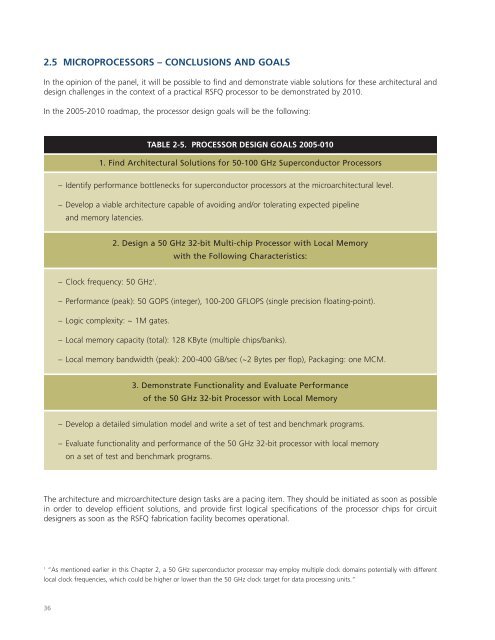Superconducting Technology Assessment - nitrd
Superconducting Technology Assessment - nitrd
Superconducting Technology Assessment - nitrd
You also want an ePaper? Increase the reach of your titles
YUMPU automatically turns print PDFs into web optimized ePapers that Google loves.
2.5 MICROPROCESSORS – CONCLUSIONS AND GOALS<br />
In the opinion of the panel, it will be possible to find and demonstrate viable solutions for these architectural and<br />
design challenges in the context of a practical RSFQ processor to be demonstrated by 2010.<br />
In the 2005-2010 roadmap, the processor design goals will be the following:<br />
TABLE 2-5. PROCESSOR DESIGN GOALS 2005-010<br />
1. Find Architectural Solutions for 50-100 GHz Superconductor Processors<br />
– Identify performance bottlenecks for superconductor processors at the microarchitectural level.<br />
– Develop a viable architecture capable of avoiding and/or tolerating expected pipeline<br />
and memory latencies.<br />
2. Design a 50 GHz 32-bit Multi-chip Processor with Local Memory<br />
with the Following Characteristics:<br />
– Clock frequency: 50 GHz 1 .<br />
– Performance (peak): 50 GOPS (integer), 100-200 GFLOPS (single precision floating-point).<br />
– Logic complexity: ~ 1M gates.<br />
– Local memory capacity (total): 128 KByte (multiple chips/banks).<br />
– Local memory bandwidth (peak): 200-400 GB/sec (~2 Bytes per flop), Packaging: one MCM.<br />
3. Demonstrate Functionality and Evaluate Performance<br />
of the 50 GHz 32-bit Processor with Local Memory<br />
– Develop a detailed simulation model and write a set of test and benchmark programs.<br />
– Evaluate functionality and performance of the 50 GHz 32-bit processor with local memory<br />
on a set of test and benchmark programs.<br />
The architecture and microarchitecture design tasks are a pacing item. They should be initiated as soon as possible<br />
in order to develop efficient solutions, and provide first logical specifications of the processor chips for circuit<br />
designers as soon as the RSFQ fabrication facility becomes operational.<br />
1<br />
“As mentioned earlier in this Chapter 2, a 50 GHz superconductor processor may employ multiple clock domains potentially with different<br />
local clock frequencies, which could be higher or lower than the 50 GHz clock target for data processing units.“<br />
36














